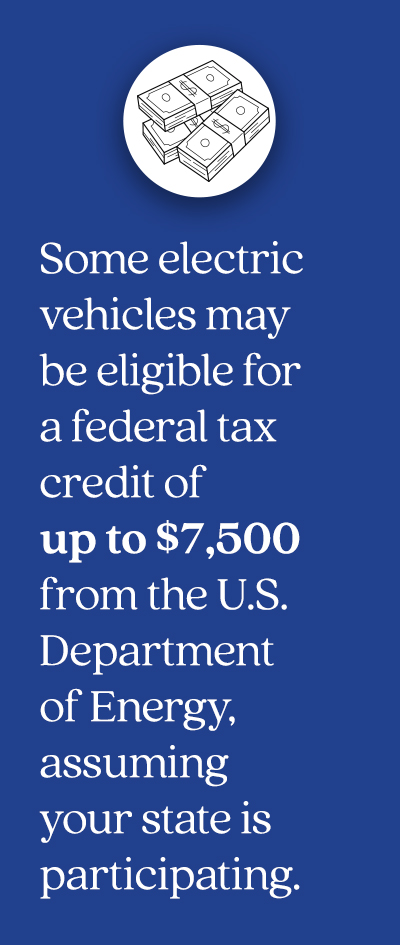Hybrid vs. Electric: Which Vehicle Type Best Matches Your Driving Habits?
Discover the benefits of these alternative-fuel vehicles so you can make an informed purchase.

First, consumers were introduced to hybrid cars, then electric vehicles (EVs). Today, both are more common on the road, with more models set to debut by the end of next year. In the fourth quarter of 2021, 11% of light-duty vehicle sales (what most of us drive) in the U.S. were hybrid, electric and plug-in electric hybrid.
With all of the different makes, models and features available, some consumers find it challenging to understand the differences between hybrids and EVs. Which one is best?
The answer depends on your needs and driving habits.
Both EVs and hybrid cars offer similar benefits, such as more efficient mileage and lower emissions compared to gas-only vehicles, but there are important distinctions. Here’s a rundown of the differences between electric cars and hybrid cars so you can decide which one is best for you.
Standard hybrid cars
A hybrid car (there are also hybrid SUVs, trucks, vans and more) pairs an electric motor with a gasoline engine. Electricity is powered by a small, high-voltage battery pack, which is separate from the vehicle’s conventional 12-volt battery.
Standard hybrid cars are driven similarly to regular vehicles and don’t need to be plugged in because electrical energy is replenished through the process of regenerative braking.
Plug-in hybrid electric vehicles (PHEV)
PHEVs are another type of vehicle in the hybrid category. Like standard hybrids, these vehicles have a traction battery pack that can be recharged by braking, but they can also be plugged into an external power source to replenish electrical stores.
With a PHEV, the gasoline engine will seamlessly switch on once the electric charge has run out, making this vehicle a popular middle-ground option for drivers looking for electric capabilities without being limited to the mileage range of an electric charge. As of September 2021, PHEVs in the U.S. provided an EPA range (distance you can go electric-only via combined city and highway driving before needing to recharge) of 14 to 65 miles.
Electric cars
EVs run on a powerful battery that allows them to operate for approximately 100 to 400 miles before needing to be recharged. As with gasoline-only cars, power efficiency depends on factors including model, year, driving conditions and driver. Here’s a list of EVs with the longest ranges in 2022.
EVs have a quick and quiet acceleration and are known for good handling on the road. At the end of your day, you can plug in your EV at home (some garage outlets may need to be adapted) and charge it overnight for the next day’s driving.
Take the guesswork out of car buying with AAA
Start Driving >>Benefits of hybrids and EVs
There are many things to consider when switching from a gasoline-only car to a hybrid or electric vehicle. Here’s a look at four of the top considerations.
- Emissions: Compared to gasoline-only cars, hybrids and EVs offer a cleaner, greener ride by producing fewer emissions and using less (or no, in the case of EVs) gasoline and engine oil. If you’re making a choice based on environmental concerns, EVs have zero tailpipe emissions.
- Mileage: Hybrids offer a higher mpg average (usually 50+ mpg) than their gas-only counterparts, which have an average of 24.2 mpg.
- Tax credit: Some electric vehicles may be eligible for a federal tax credit of up to $7,500 from the U.S. Department of Energy, assuming your state is participating. There are restrictions, including which brands are eligible, so check with your state’s Department of Motor Vehicles for details.
- Choice: There are far more options for gas-only cars than for hybrid or electric vehicles. As of September 2022, there only were 32 different EV models available in the U.S., from brands such as Tesla and Kia, and 34 different plug-in hybrid models available, with the Jeep Wrangler 4xe being the most popular.

Cost and repairs for alternative vehicles
Hybrid cars will require many of the maintenance steps that their gasoline-only counterparts do, such as oil changes, transmission checks, fluid changes, belt replacement, etc. By contrast, electric cars tend to be a lower-maintenance option, but they still require care, including some fluid changes, tire changes, and brake maintenance.

Vehicle selection
For some people, the choice between an EV and a hybrid may come down to the availability of a preferred make or model. But if you’re open to both vehicle types, consider this: If you’re in need of a daily commuter car, an electric car is often the best choice because it can be plugged in at home, possibly at work (if your workplace has a charging station) or at a public charging station. There are now nearly 5,700 public-access EV charging stations in the U.S. and more than 300 in Canada. (This information is available through the AAA Mobile app.)
However, if you plan to travel often or for long distances, select a hybrid so you can use both electric and gas power to efficiently get you to your destination.
Fuel savings, environmental concerns and cost are three considerations for consumers looking at alternative-fuel vehicles. And with more brands jumping into the fray, deciding between an EV or hybrid often comes down to lifestyle and personal preference.